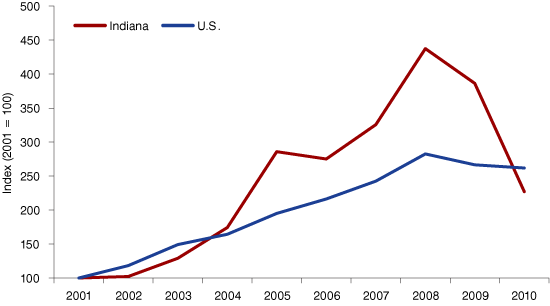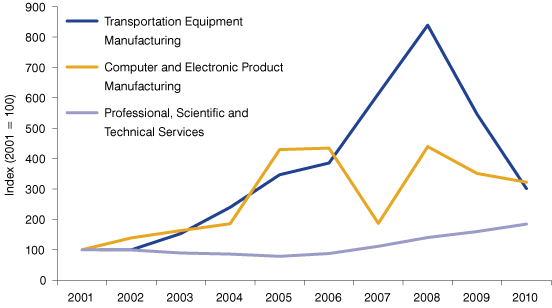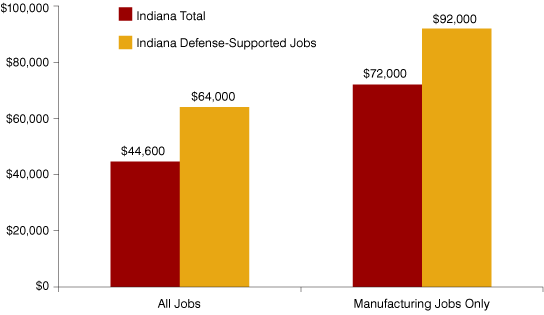The Economic Bootprint of Defense Spending in Indiana
The growing prominence of the defense industry in Indiana may be one of the most important untold stories of the last decade. In 2010, more than 1,100 Indiana companies received defense-related contracts from the federal government, with 1,088 firms awarded contracts from the Department of Defense (DoD), and 133 firms working with the Department of Homeland Security (DHS). Overall, 2010 saw Indiana companies claim 9,889 defense contracts worth a total of more than $4 billion.1
Since 2001, the value of defense contracts awarded to Indiana has more than doubled, the annual number of unique contracts awarded has increased nearly five-fold, and the number of Indiana defense contractors has grown significantly (see Table 1). The 2010 value of Indiana's defense-related contracts ranked 23rd among states.
Table 1: Indiana Defense Contract Awards, FY 2001 to FY 2010*
| Fiscal Year | Number of Contractors | Number of Contracts | Total Value of Contracts |
|---|---|---|---|
| 2001 | 362 | 2,114 | $1,781,599,723 |
| 2002 | 477 | 3,839 | $1,823,460,354 |
| 2003 | 519 | 6,615 | $2,299,897,248 |
| 2004 | 786 | 7,378 | $3,105,494,963 |
| 2005 | 1,073 | 13,649 | $5,093,579,488 |
| 2006 | 1,097 | 8,366 | $4,901,644,892 |
| 2007 | 1,160 | 9,811 | $5,801,657,854 |
| 2008 | 1,196 | 10,939 | $7,795,067,767 |
| 2009 | 1,216 | 9,582 | $6,881,788,924 |
| 2010 | 1,136 | 9,889 | $4,037,339,824 |
* Place, or state, of award may not necessarily be the state where the contract work is performed.
Source: Indiana Business Research Center, using usaspending.gov data
Growth in the value of contracts awarded to Indiana companies outpaced total defense-related contracting over much of the past decade (see Figure 1). At the 2008 peak, Indiana's $7.8 billion in contracts was more than four-times greater than the 2001 level. All U.S.-based contracting increased by just less than three-times over the same period.
While the value of defense-related contracts in 2010 was roughly half of the 2008 level, the number of contracts awarded to Hoosier businesses, as well as the number of contractors receiving awards, has remained at historically high levels. Perhaps the sizeable dip in the value of contracts between 2009 and 2010 is a short-term anomaly, but data suggest a more fundamental shift in the nation's defense needs and a slowdown in contract values.
Figure 1: Change in the Value of Defense Contract Awards, Indiana and the United States, FY 2001 to FY 2010

Source: Indiana Business Research Center, using usaspending.gov data
Key Defense Industry Sectors
A large part of Indiana's surge in defense contract dollars can be attributed to a single company: AM General. This South Bend and Mishawaka-based manufacturer of the Humvee—(as well as other transportation-related products)—accounted for 44 percent of all defense contract dollars to the state in 2006 and roughly 60 percent of the total in both 2007 and 2008. In all, AM General claimed 41 percent of all defense contract dollars awarded to Indiana companies between 2001 and 2010.
Indiana's relative strength in transportation equipment manufacturing (TEM) is evident in the defense contract awards: more than half of the total value of contracts over the decade were in the TEM sector (see Table 2). In addition to motor vehicle manufacturing, this broad sector also includes aircraft and guided missile manufacturing activities. The sale of computer and electronic products placed a distant second with 16 percent of the total value, followed by professional and scientific services at 6 percent. Together, these three industries combined to claim three out of every four dollars in Indiana's defense-related contracts.
Table 2: Indiana's Top Defense Industry Sectors by Dollar Value, FY 2001 to FY 2010
| Industry Sector | Rank | Value of Contracts | Percent of Total |
|---|---|---|---|
| Transportation equipment manufacturing | 1 | $23,532,637,707 | 54.1% |
| Computer and electronic product manufacturing | 2 | $6,910,740,440 | 15.9% |
| Professional, scientific and technical services | 3 | $2,498,703,296 | 5.7% |
| Nondurable goods merchant wholesalers | 4 | $1,618,906,619 | 3.7% |
| Fabricated metal product manufacturing | 5 | $867,501,470 | 2.0% |
| Food manufacturing | 6 | $811,066,490 | 1.9% |
| Machinery manufacturing | 7 | $744,087,323 | 1.7% |
| Petroleum and coal products manufacturing | 8 | $717,694,677 | 1.6% |
| Heavy and civil engineering construction | 9 | $700,718,458 | 1.6% |
| Waste management and remediation services | 10 | $500,844,699 | 1.2% |
| All others | $4,618,629,856 | 10.6% | |
| Total | $43,521,531,036 | 100% |
Source: Indiana Business Research Center, using usaspending.gov data
While contract activity in TEM has cooled in recent years, and TEM contract dollars will likely diminish as the dual wars wind down, contract dollars to Indiana's professional, scientific and technical service providers have more than doubled between 2005 and 2010 (see Figure 2). Given the recent growth of businesses associated with the WestGate @ Crane Technology Park, one may expect continued growth in contract dollars for professional, scientific and technical service providers. This suggests that the DoD and DHS are contracting with Indiana businesses for services that require higher human capital.
Figure 2: Change in the Value of Indiana's Defense Contracts, Select Industries, FY 2001 to FY 2010

Source: Indiana Business Research Center, using usaspending.gov data
Indiana's Top Defense Contractors
With more than $3 billion in awards, Indiana's top 10 defense contractors in 2010 span a wide range of industries and claim more than 75 percent of the state's total contract dollars (see Table 5). The largest recipient, AM General, is primarily a manufacturer of motor vehicle-related products including the Humvee. Rolls-Royce supplies the military with a range of aircraft-related goods and R&D. Raytheon manufactures a host of different technological products for defense purposes. ITT Corporation's contribution to Indiana's defense contracts consists mainly of manufacturing wireless communication equipment. Finally, Calumet Specialty Products provides liquid fuel products and Ameriqual Group is one of only three companies approved to supply “Meals, Ready-to-Eat” (MRE) to the DoD.
Table 5: Top Indiana Defense Contractors, FY 2010
| Company | Location | Contract Value | Percent of Total Indiana Contract Value |
|---|---|---|---|
| AM General | South Bend/Mishawaka | $1,077,297,716 | 26.7% |
| Rolls-Royce Group, PLC | Indianapolis | $733,056,959 | 18.2% |
| Raytheon Company | Indianapolis/Fort Wayne | $665,257,188 | 16.5% |
| ITT Corporation | Fort Wayne | $392,205,396 | 9.7% |
| Calumet Specialty Products | Indianapolis | $132,208,000 | 3.3% |
| Ameriqual Group, LLC | Evansville | $120,505,603 | 3.0% |
| Petroleum Traders | Fort Wayne | $120,309,790 | 3.0% |
| ERAPSCO | Columbia City | $87,009,407 | 2.2% |
| Tri Star Engineering, Inc. | Bedford | $50,966,293 | 1.3% |
| Kimball International, Inc. | Jasper | $27,704,505 | 0.7% |
| All Others | $630,818,968 | 15.6% | |
| Total | $4,037,339,824 | 100.0% |
Source: Indiana Business Research Center, using usaspending.gov data
The Location of Indiana Contract Awards
More than 80 percent of Indiana's 2010 defense contract dollars were concentrated in three counties (see Figure 4). Thanks to the presence of large players such as Rolls Royce and Raytheon, Marion County (Indianapolis) topped the list with $1.4 billion in 2010 contracts. Close behind at $1.1 billion is St. Joseph County (South Bend/Mishawaka)—home to AM General and a division of Honeywell. Raytheon and ITT helped Allen County (Fort Wayne) place third with $863 million in contracts.
While these are three of Indiana's larger counties, defense spending makes significant contributions to some of the state's smaller counties, as well. With U.S. Navy suppliers ERAPSCO and UnderSea Sensor Systems calling Columbia City home, Whitley County ranked fifth among counties in 2010 with contracts totaling $91 million. Bedford-based Tri Star Engineering helped spur Lawrence County to sixth on the list with $59 million in 2010 awards while furniture sales by Kimball International pushed Dubois County (Jasper) to seventh with $39 million in contracts.
Figure 4: Value of Indiana Defense Contracts by County, FY 2010

Source: Indiana Business Research Center, using usaspending.gov data
While Indiana companies were awarded $4.0 billion in defense contracts in 2010, a small share of these awards ($300 million) was performed in other states. By the same token, Indiana establishments served as the place of performance for contracts awarded elsewhere. In addition to the $3.7 billion in contracts both awarded and performed in the state, Indiana establishments fulfilled the production of an additional $700 million in contracts received by entities in other states. In that sense, Indiana was a net importer of defense production in 2010.
Defense Contracts Support High-Paying Jobs
One defining characteristic of defense spending in Indiana is that the contracts tend to be concentrated in high-wage industries. According to the IMPLAN model used to estimate the economic impact of the defense industry, the estimated average compensation for direct defense-supported jobs was nearly $20,000 greater than Indiana's average compensation per worker for all jobs (see Figure 7).
This is not exactly an apples-to-apples comparison given that the Indiana total includes the full spectrum of industries including large numbers of lower-wage jobs in retail, food service, etc. That said, there is a similar gap when comparing manufacturing jobs alone. Indiana's average compensation per manufacturing job was $72,000 in 2009 compared to $92,000 for manufacturing jobs directly supported by defense contracts. It is clear by this measure that the nature of defense contracts helps to boost the state's standard of living.
Figure 7: Indiana's Compensation per Job, 2009

Note: The compensation per defense-supported job reflects direct effect jobs only. Indirect and induced effects are not included.
Source: Indiana Business Research Center, using usaspending.gov data and IMPLAN economic modeling software
Conclusion
The importance of defense contracts to the Indiana economy is clear. Considering the types of jobs these contracts create magnifies the benefits of defense spending on the state. Defense dollars are heavily concentrated in high-tech, high-wage industries such as auto, truck and aircraft-related manufacturing; communication equipment manufacturing; and professional and scientific services. In this sense, not only does defense contracting generate a significant number of jobs, it generates the type of jobs that Indiana needs.
These DoD and DHS contracts and the jobs they create directly by the firms that win the awards also have ripple effects. That is, these contracts and jobs support other Hoosier jobs, whether along the supply chain or through household spending on such things as healthcare, utilities, groceries or entertainment. All told, the combined economic effects of this spending generated $7.5 billion total economic output in the state in 2010 and supported an estimated 38,600 jobs. Add in the effects of payrolls at the state's defense facilities (i.e., Crane, Defense Finance and Accounting Services, etc.) and these estimates jump to $8.3 billion in output and 56,600 jobs.
These impacts have increased over the decade, too. The estimate for the total jobs supported by defense spending increased nearly five-fold between 2001 and 2008, when the value of contracts was at its peak. The numbers have slipped since then, but the 2010 employment effect was still more than three-times greater than the 2001 mark.
This fluctuation in the value of defense contracts awarded to Hoosier businesses will bear watching in the coming years. Growth in contract dollars has significant positive ripple effects throughout the state's economy, but declining contract awards would place those positive effects in jeopardy. Contract levels are bound to change as the nation's defense needs evolve and federal budget priorities shift. The direction of these changes will be an important economic indicator for Indiana.
To learn more, read the full report, Building National Security: The Economic Impact of Indiana's Defense Industry.
Notes
- The $4 billion figure may understate the size of the DoD and DHS "bootprint " in the state. The publically available database on federal expenditures—USAspending.gov—may not include some of the spending on equipment and supplies at the state's military facilities like Crane or Camp Atterbury. At this time, however, it is unknown how much of this spending is missed by USAspending.gov. It could be a sizeable figure given that contracts to Indiana business from Crane alone totaled nearly $500 million in 2010..
Timothy F. Slaper, Ph.D.
Director of Economic Analysis, Indiana Business Research Center, Indiana University Kelley School of Business
Matt Kinghorn
Demographer, Indiana Business Research Center, Indiana University Kelley School of Business
Ryan Krause
Research Assistant, Indiana Business Research Center, Indiana University Kelley School of Business
